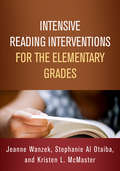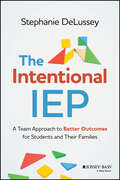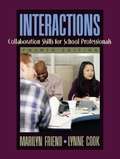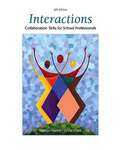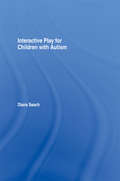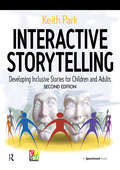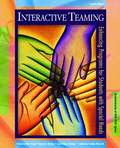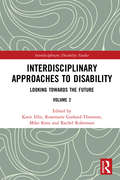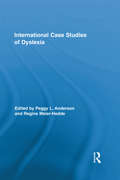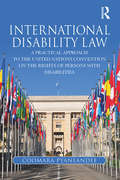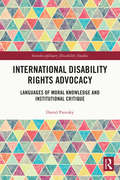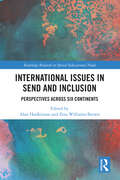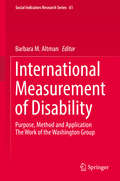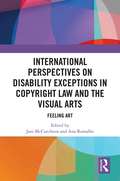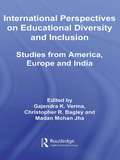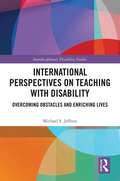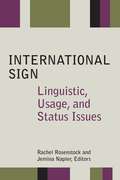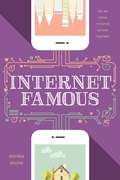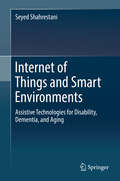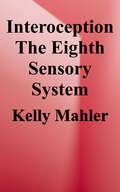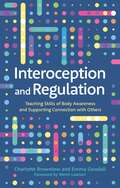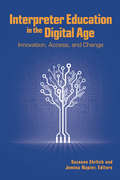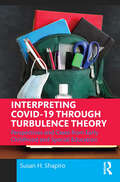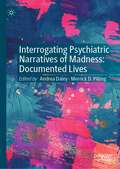- Table View
- List View
Intensive Reading Interventions for the Elementary Grades (The Guilford Series on Intensive Instruction)
by Jeanne Wanzek Stephanie Al Otaiba Kristen L. McMasterPacked with easy-to-use tools and resources, this book presents intensive intervention strategies for K–5 students with severe and persistent reading difficulties. Filling a key need, the authors describe specific ways to further intensify instruction when students continue to struggle. Chapters address all the fundamental components of reading--phonological awareness, phonics and word recognition, reading fluency, oral language, language and reading comprehension, and writing to read. The authors discuss the design and implementation of intensive instruction and provide effective teaching techniques and activities. Grounded in the principles of data-based individualization, the book includes concrete recommendations for determining students' particular needs and monitoring their progress.
The Intentional IEP: A Team Approach to Better Outcomes for Students and Their Families
by Stephanie DeLusseyLearn how to put together IEPs with the power to make a real difference for students The Intentional IEP shows special education teachers how to successfully collaborate with all stakeholders—parents or guardians, general ed teachers, therapists, and beyond—to work toward students’ success. Too many of us aren’t trained to write the Individualized Education Programs that help millions of students with thrive in school. This book fills that training gap, explaining the importance of assembling an IEP team and inviting this team to confront and improve its current processes and habits to make IEP writing simpler and more effective. With all the pressures that educators are under, it’s easy to cut corners when it comes time towrite IEPs. Writing them in isolation, leaving them to the night before, making decisions without consulting data and research, letting family collaboration fall to the wayside—most special educators have made these mistakes at some point. The Intentional IEP equips you with the resources you need to feel confident in approaching IEPs the right way, including prioritizing the many competing demands you face so you can find the capacity to show up for your students. This book offers: Clear, step-by-step solutions for all IEP members that can easily be implemented at any time during the school year Collaboration strategies for IEP teammates to rely on one another for expert and professional knowledge Tools and reproducibles to strengthen practices and overcome common hurdles Direct advice from a veteran special education teacher who has seen what a difference collaboration in the IEP can make for studentsThe Intentional IEP is a timely resource for special education teachers, general education teachers, and support staff, as well as teachertraining programs. Parents and guardians with students will also benefit from this clearly written guide to the IEP.
Interactions: Collaboration Skills for School Professionals (4th Edition)
by Marilyn Friend Lynne CookInteractions, Fourth Edition, provides a cutting-edge look at how teams of school professionals-classroom teachers, special education teachers, and counselors-can effectively work together to provide a necessary range of services to students with special needs. This book addresses collaboration as a style, with accompanying knowledge and skills, which guides practices in many education efforts. As a result, future teachers learn how to collaborate with school professionals and families to help special education students who are more often being placed in general classroom settings.
Interactions: Collaboration Skills for School Professionals
by Marilyn Friend Lynne CookTargeted at services for students with special needs, this text provides collaboration techniques between educators fraternity - special educators, general educators and related services professionals - to work towards effective communication framework.
Interactive Play for Children with Autism
by Diana SeachThis is a comprehensive guide to establishing shared play experiences that assist in the development of communication, social understanding and cognition. Easily accessible, and packed full of practical resources, the book defines the importance of play both developmentally and psychologically as having a major influence on the enrichment of meaningful interactions and children’s learning. Diana Seach expertly discusses how play enables children with Autism to: represent their knowledge of the world and their relationships with others spontaneously explore ways of thinking about themselves and the objects they encounter develop communication and companionship discover motivating ways to learn extend their imagination and creative potential. Those who live and work with children who have Autism and Asperger Syndrome will find Interactive Play for Children with Autism an invaluable tool when implementing strategies to develop interactive play in educational establishments, care settings and the family home.
Interactive Storytelling: Developing Inclusive Stories for Children and Adults
by Keith ParkInteractive storytelling, where the story is spoken or chanted, began as a way to include individuals with severe and profound learning disabilities in larger group activities, whether children at school or adults in day services. The stories are performed in call-and-response - one person calls out a line and the rest of the group respond either by calling back the same line or by calling out a pre-arranged response - and require no previous experience in drama or storytelling. They can be performed anywhere, by anyone. Various stories are explored, ranging from folktales and pantomime to poetry, the works of Charles Dickens, Shakespeare and stories from the Old Testament. Each extract details the full call-and-response for performing the story. This approach to storytelling can be used by teachers and group facilitators in a variety of settings and with any group of children or adults, irrespective of their level of disability. This hands-on manual will enable teachers, therapists, parents and anyone working with children or adults in community settings to use performance and recital to bring stories, drama and poetry to life for people of all abilities. 'This book is a useful resource...is simply written...is especially appropriate for people working with children and adults with speech, language and communication difficulties.' - Child Language Teaching and Therapy.
Interactive Teaming: Enhancing Programs for Students with Special Needs (4th edition)
by Vivian Ivonne Correa Hazel Jones Carol Chase Thomas Catherine Voelker MorsinkInteractive teaming in special programs is a concept of service delivery for school-age students who are currently placed in special education programs or are at risk for referral to such programs.
Interdisciplinary Approaches to Disability: Looking Towards the Future: Volume 2 (Interdisciplinary Disability Studies)
by Katie Ellis Rosemarie Garland-Thomson Mike Kent Rachel RobertsonHow can a deep engagement with disability studies change our understanding of sociology, literary studies, gender studies, aesthetics, bioethics, social work, law, education, or history? Interdisciplinary Approaches to Disability (the companion volume to Manifestos for the Future of Critical Disability Studies) identifies both the practical and theoretical implications of such an interdisciplinary dialogue and challenges people in disability studies as well as other disciplinary fields to critically reflect on their professional praxis in terms of theory, practice, and methods. Topics covered include interdisciplinary outlooks ranging from media studies, games studies, education, performance, history and curation through to theology and immunology. Perspectives are drawn from different regions from the European Union to the Global South with chapters that draw on a range of different national backgrounds. Our contributors who write as either disabled people or allies do not proceed from a singular approach to disability, often reflecting different or even opposing positions. The collection features contributions from both established and new voices in international disability studies outlining their own visions for the future of the field. Interdisciplinary Approaches to Disability will be of interest to all scholars and students working within the fields of disability studies, cultural studies, sociology, law history and education. The concerns raised here are further in Manifestos for the Future of Critical Disability Studies.
International Case Studies of Dyslexia (Routledge Research in Education)
by Peggy L. Anderson Regine Meier-HeddeDyslexia is a disability that exists in all countries that have high expectations for literacy. The inability to read in spite of normal intellectual potential represents one of the most puzzling educational challenges for literate societies, regardless of the culture or language. This book examines medical, psychological, educational, and sociological data from comprehensive case studies of preteen dyslexic children, in order to profile the disability as it occurs in seventeen different nations. Interviews with the children and their parents reveal how children with dyslexia are identified and treated around the world, and provide a look at various perceptions of dyslexia and its challenges. Researchers and practitioners in education, psychology, and health-related professions will find this case book to be an excellent reference. Parents of children with dyslexia will find the advocacy recommendations helpful.
International Disability Law: A Practical Approach to the United Nations Convention on the Rights of Persons with Disabilities
by Coomara PyaneandeeThis book provides a concise guide to international disability law. It analyses the case law of the CRPD Committee and other international human rights treaty bodies, and provides commentaries on more than 50 leading cases. The author elaborates on the obligations of States Parties under the CRPD and other international treaties, while also spelling out the rights of persons with disabilities, and the different mechanisms that exist at both domestic and international levels for ensuring that those rights are respected, protected and promoted. The author also delineates the traditional differentiation between civil and political rights on the one hand, and economic, social and cultural rights on the other. He demonstrates, through analysis of the evolving case law, how the gap between these two sets of rights is gradually closing. The result is a powerful tool for political decisionmakers, academics, legal practitioners, law students, persons with disabilities and their representative organisations, human rights activists and general readers.
International Disability Rights Advocacy: Languages of Moral Knowledge and Institutional Critique (Interdisciplinary Disability Studies)
by Daniel PateiskyThis book provides insight into the globally interlinked disability rights community and its political efforts today. By analysing what disability rights activism contributes to a global power apparatus of disability-related knowledge, it demonstrates how disability advocacy influences the way we categorise, classify, distribute, manipulate, and therefore transform knowledge. By unpacking the mutually constitutive relations between (practical) moral knowledge of international disability advocates and (formal) disability rights norms that are codified in international treaties such as the UN Convention on the Rights of Persons with Disabilities (CRPD), the author shows that the disability rights movement is largely critical of statements that attempt to streamline it. At the same time, cross-cultural disability rights advocacy requires images of uniformity to stabilise its global legitimacy among international stakeholders and retain a common meta-code that visibly identifies its means and aims. As an epistemic community, disability rights advocates simultaneously rely on and contest the authority of international human rights infrastructure and its language. Proving that disability rights advocates contribute immensely to a global culture that standardises what is considered morally and legally ‘right’ and ‘wrong’, thereby shaping the human body and the body politic, this book will be of interest to all scholars and students of disability studies, sociology of knowledge, legal and linguistic anthropology, social inequality, and social movements.
International Issues in SEND and Inclusion: Perspectives Across Six Continents (Routledge Research in Special Educational Needs)
by Alan Hodkinson Zeta Williams-BrownInternational Issues in SEND and Inclusion brings together a collection of cutting-edge researches on approaches to special education needs and disability education, across 6 continents and within 12 countries. Written by authors who are experts in their own countries in relation to special educational needs and disability, the book provides a unique knowledge and understanding of different international perspectives in special educational needs, disability and inclusion. The chapters present extended case studies and reflect on current policy, practice and theory within that context, challenging assumptions which can dominate the policy and practice of inclusive education. Each of the six continents has a separate section and introduction within the book to offer a relevant approach and context for analysis. The book will be of great interest to academics, researchers and postgraduate students in the fields of inclusion, special educational needs and disability, teacher education and comparative education.
International Measurement of Disability
by Barbara M. AltmanThis volume provides an informed review of the accomplishments of the Washington Group on Disability Statistics (WG) in the provision of international data and statistics on disability. It does so within the context of the UN Convention on the Rights of Persons with Disabilities. The volume includes a description of the development and testing of a short set of questions for Censuses, now used in approximately 29 countries and recommended in the U. N. 's Principles and Recommendations for Population and Housing Censuses: The 2020 Round, which includes disability as a core topic to be collected in censuses. It discusses the experiences of several countries on the use of the WG questions and how this has impacted on national agendas in the area of disability. It follows the development and testing of an extended set of questions for use in national surveys other than censuses and examines the challenges of translation and the importance of generating comparable question sets in different languages and within different cultures. It studies the examination of cognitive testing techniques in a variety of countries, and presents the results of the first round of censuses in 2010 in countries using the six question set. The volume includes discussions of the new development of question modules on a broad range of child disability and functioning, and the environmental contexts of participation that are part of the current work of the WG. In addition, it contains a reflection on the use of the WG's functionality approach to identifying disabilities by humanitarian agencies to identify disabilities in populations of displaced persons. A thoughtful conclusion addresses what the development of cross-nationally comparable data can mean for the improvement of circumstances for all persons with disabilities.
International Perspectives on Disability Exceptions in Copyright Law and the Visual Arts: Feeling Art
by Jani McCutcheon and Ana RamalhoThis book provides an overview of disability exceptions to copyright infringement and the international and human rights legal framework for disability rights and exceptions. The focus is on those exceptions as they apply to visual art, while the book presents a comprehensive study of copyright’s disability exceptions per se and the international and human rights law framework in which they are situated. 3D printing now allows people with a visual impairment to experience 3D reproductions of paintings, drawings and photographs through touch. At the same time, the uncertain application of existing disability exceptions to these reproductions may generate concerns about legal risk, hampering sensory art projects and reducing inclusivity and equity in cultural engagement by people with a visual impairment. The work adopts an interdisciplinary approach, with contributions from diverse stakeholders, including persons with disabilities, cultural institutions and the 3D printing industry. The book sketches the scene relating to sensory art projects. Experts in intellectual property, human rights, disability and art law then critically analyse the current legal landscape relating to disability access to works of visual art at both international and regional levels, as well as across a broad representative sample of national jurisdictions, and identify where legal reform is required. This comparative analysis of the laws aims to better inform stakeholders of the applicable legal landscape, the legal risks and opportunities associated with sensory art and the opportunities for reform and best practice guidelines, with the overarching goal of facilitating international harmonisation of the law and enhanced inclusivity.
International Perspectives on Educational Diversity and Inclusion: Studies from America, Europe and India
by Gajendra K. Verma Christopher R. Bagley Madan Mohan JhaIn light of new theories of multiculturalism and globalization, this insightful book compares approaches to the educational inclusion of diverse minorities– such as the ethnic and linguistic minorities in America. Drawing on their extensive experience, the contributors examine: accounts from cross-cultural cognitive psychology on the special interests and educational needs of certain ethnic groups research on social class divisions, neighbourhood poverty and school exclusions in Britain educational developments for inclusion of minorities in Europe, Greece and Eastern Europe India's educational policies surrounding its struggle to achieve 'education for all' in a nation at the threshold of economic prosperity. This book is unique in its breadth, and scope of its integration of educational policy data generated by different countries, with contrasted minority populations, all at different stages of development.
International Perspectives on Teaching with Disability: Overcoming Obstacles and Enriching Lives (Interdisciplinary Disability Studies)
by Michael S. JeffressEfforts to reduce discrimination and increase diversity on campuses, coupled with shrinking budgets causing administrators to devote more resources toward recruiting and retaining students with disabilities, are fuelling an explosion of research in the area of inclusive education. An important focus that has been largely neglected is the place of teachers with disabilities in academe. International Perspectives on Teaching with Disability brings together 25 multi-disciplinary scholars with disabilities from Africa, Canada, the Caribbean, the UK, Israel and the United States to share their struggles and successes in teaching with disability. The 18 chapters are written largely from autoethnographic perspectives grounded in solid academic research but full of anecdotes and self-reflexive narratives that provide insights into the lived experiences of the authors. Woven into the narratives are discussions of the complexities of self-disclosure and self-advocacy; the varied—and often problematic—ways disability is experienced, perceived and discussed in society and in the classroom; the challenges of navigating academe with disability, the value of disability pedagogy, the positive student outcomes achieved by teaching through disability, as well as practical applications and lessons learned that will benefit educators, administrators and students preparing to become teachers. This book is written to champion the integral place and role of disabled educators in academe. Current educators with disability will be affirmed. Those with disability aspiring to become teachers will be encouraged. Temporarily able-bodied administrators and educators will be challenged. Everyone will be informed. This book will be a welcome addition to reading lists in a wide array of academic fields including: Education, Pedagogy, Disability Studies, Human Resources Management, and Sociology.
International Sign: Linguistic, Usage, and Status Issues
by Jemina Napier Rachel RosenstockInternational Sign (IS) is widely used among deaf people and interpreters at international events, but what exactly is it, what are its linguistic features, where does its lexicon come from, and how is it used at interpreted events? This groundbreaking collection is the first volume to provide answers to these questions. Editors Rachel Rosenstock and Jemina Napier have assembled an international group of renowned linguists and interpreters to examine various aspects of International Sign. Their contributions are divided into three parts: International Sign as a Linguistic System; International Sign in Action—Interpreting, Translation, and Teaching; and International Sign Policy and Language Planning. The chapters cover a range of topics, including the morphosyntactic and discursive structures of interpreted IS, the interplay between conventional linguistic elements and nonconventional gestural elements in IS discourse, how deaf signers who use different signed languages establish communication, Deaf/hearing IS interpreting teams and how they sign depicting verbs, how best to teach foundation-level IS skills, strategies used by IS interpreters when interpreting from IS into English, and explorations of the best ways to prepare interpreters for international events. The work of the editors and contributors in this volume makes International Sign the most comprehensive, research-based analysis of a young but growing field in linguistics and interpretation.
Internet Famous
by Danika Stone<P>An engaging and relatable novel for the digital age that perfectly captures the complicated interaction between what goes on in our real lives and what we say online. <P>Internet sensation Madison Nakama has it all! Her pop-culture rewatch site has a massive following, and fans across the world wait on her every post and tweet. And now Laurent, a fellow geek (and unfairly HOT French exchange student!), has started flirting with her in the comments section of her blog. But Laurent’s not the only one watching for Madi’s replies… Internet fame has a price, and their online romance sparks the unwanted attention of a troll. <P>When Madi’s “real life” hits a rough patch, she feels her whole world crumbling. With Laurent’s support, can Madi rally her friends across the globe to beat the troll, or will he succeed in driving her away from everything—and everyone—she loves? <P>Internet Famous is a fresh, contemporary young adult romance for the iGeneration from Danika Stone, author of All the Feels.
Internet of Things and Smart Environments
by Seyed ShahrestaniThis book is focused on the Internet of Things (IoT) services and smart environments that can be of assistance to the elderly and individuals living with dementia or some sensory impairment. The book outlines the requirements of the systems that aim to furnish some digital sensory or cognitive assistance to the individuals and their caregivers. Internet of Things and Smart Environments: Assistive Technologies for Disability, Dementia, and Aging covers the important evolutions of the IoT, the sensors, actuators, wireless communication and pervasive computing systems, and other enabling technologies that power up this megatrend infrastructure. The use of the IoT-based systems in improving the conventional assistive technologies and provisions of ambient assisted living are also covered. The book takes an impartial, and yet holistic, view to providing research insights and inspirations for more development works in the areas related to assistive IoT. It will show the potentials of using normally available interactive devices, like smartphones or smart TVs, which can be supplemented with low-cost gadgets or apps to provide assistive capabilities. It aims to accentuate the need for taking a comprehensive and combinatory view of the comprising topics and approaches that are based on the visions and ideas from all stakeholders. The book will examine these points and considerations to conclude with recommendations for future development works and research directions. This book can be of value to a diverse array of audience. The researchers and developers in healthcare and medicine, aged care and disability services, as well as those working in the IoT-related fields, may find many parts of this book useful and stimulating. It can be of great value to postgraduate and research students working in these areas. It can also be adapted for use in upper-level classroom courses relevant to communication and smart technologies, IoT applications, and assistive technologies. Many parts of the book can be of interest to the elderly and individuals living with a disability, as well as their families and caregivers. From an industry perspective, it can be of interest to software, hardware, and particularly app developers working on the IoT applications, smart homes and environments, and assistive technologies for the elderly and people living with disability or dementia.
Interoception: The Eighth Sensory System
by Kelly MahlerInteroception, a newly identified eighth sense, allows us to "feel our internal organs and skin and gives information regarding the internal state or condition of our body." As such it is also a key component of our emotional experience. This is an area of difficulty for many, including those with autism spectrum disorders. <p><p>The book reviews the research underlying the effects of poor interoception and outlines strategies for how to ameliorate these effects.--Publisher
Interoception and Regulation: Teaching Skills of Body Awareness and Supporting Connection with Others
by Emma Goodall Charlotte BrownlowThere are some things that many of us take for granted - such as knowing when we are hot or cold, feel hungry, or need to go to the toilet. But how do we know these things, and why do some people struggle to recognise them? Interoception - the ability to identify and act on physical sensations inside the body - is crucial to human well-being. It underpins physical developmental milestones, such as toilet-training, as well emotional ones, such as the ability to self-regulate. Research shows that Autism often co-occurs with poor interoceptive sense.This practical and informative book demystifies interoception and provides tools to help boost interoceptive abilities. It summarises the latest research, explores how interoceptive difficulties can be identified, suggests strategies to manage feelings and emotions, and explains how to support individuals in 'tuning in' to themselves.
Interpreter Education in the Digital Age: Innovation, Access, and Change
by Jemina Napier Suzanne EhrlichThis collection brings together innovative research and approaches for blended learning using digital technology in interpreter education for signed and spoken languages. Volume editors Suzanne Ehrlich and Jemina Napier call upon the expertise of 21 experts, including themselves, to report on the current technology used to provide digital enhancements to interpreter education in Australia, New Zealand, Brazil, Belgium, the United Kingdom, and the United States. Divided into three parts, Innovation, Change, and Community Engagement, this study focuses on the technology itself, rather than how technology enhances curriculum, delivery, or resources. Initiatives described in this collection range from the implementation of on-demand interpreting using iPad technology to create personalized, small-group, multidimensional models suited to digital media for 160 languages; introducing students to interpreting in a 3D world through an IVY virtual environment; applying gaming principles to interpreter education; assessing the amenability of the digital pen in the hybrid mode of interpreting; developing multimedia content for both open access and structured interpreter education environments; to preparing interpreting students for interactions in social media forums, and more. Interpreter Education in the Digital Age provides a context for the application of technologies in interpreter education from an international viewpoint across languages and modalities.
Interpreting COVID-19 Through Turbulence Theory: Perspectives and Cases from Early Childhood and Special Education
by Susan H. ShapiroThrough the lens of Turbulence Theory, this volume offers students and scholars an innovative toolkit for understanding the COVID-19 pandemic and its impact on teachers, families, and students. Bringing together cases from early childhood and special education written by parents and educators, author Susan H. Shapiro leverages Turbulence Theory as a framework to help readers evaluate the level of turbulence during each scenario and what methods, if any, might help mitigate or escalate the situation. With more than 20 insightful case-based examples and discussion questions, this book explores what lessons and strategies we can bring into future crises—and how we move forward in an ever-evolving educational landscape.
Interpreting Disability: A Qualitative Reader
by Philip M. Ferguson Dianne M. Ferguson Steven J. TaylorThis text provides stories that illustrate interpretivistic research related to disability.
Interrogating Psychiatric Narratives of Madness: Documented Lives
by Andrea Daley Merrick D. PillingThis book challenges the perception of the psychiatric chart as a neutral and objective text. The chapters included in this book coalesce to reveal the psychiatric chart as a text that is, in fact, “storied” by institutional ideology that reflects, reinforces, reinterprets, and, at times, resists gendered, raced, sexualized, and classed norms, values, and presuppositions. Intersectional analysis highlights the nuanced ways in which dominant ideologies are activated in chart documentation to produce qualitatively specific psychiatric narratives of distress and related responses in the psychiatric institution. The book serves as a much-needed resource for mental health professionals, education and training programs, and researchers that meaningfully takes into account the social and structural materiality of people’s lives and its impact on experiences of distress. It will also appeal to scholars investigating equity in health care across the fields of Critical Psychology, Disability Studies, Social Work, Allied Health, Mad Studies and Social Justice.
